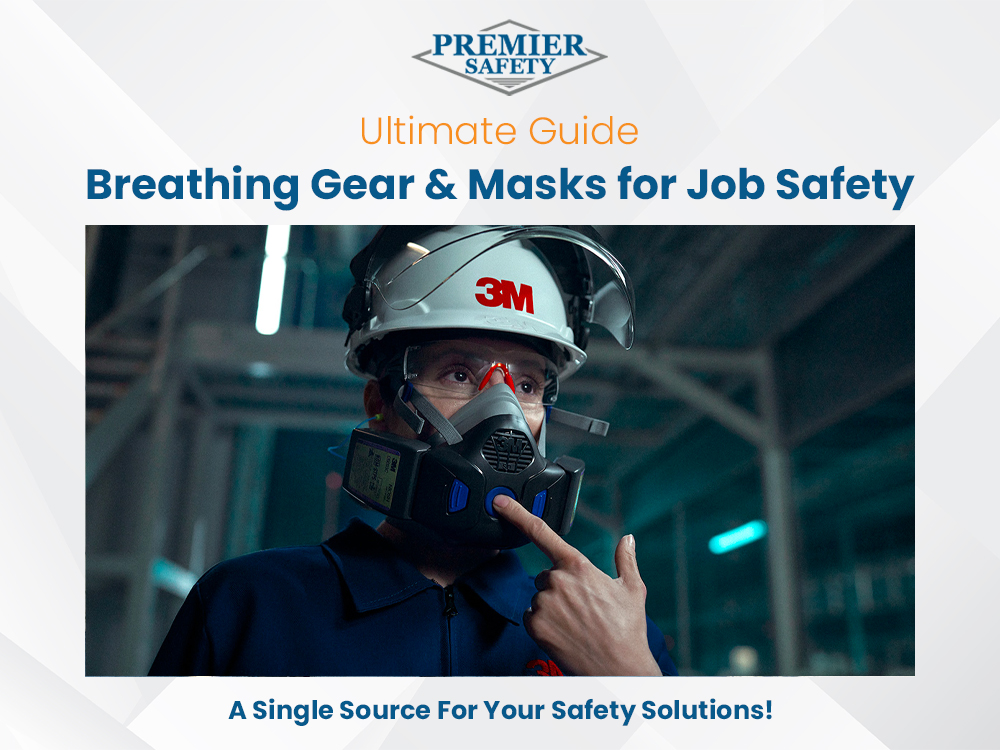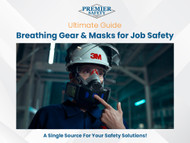Ultimate Guide: Breathing Gear & Masks for Job Safety
Mar 23rd 2023

Ultimate Guide: Breathing Gear & Masks for Job Safety
The workplace can be a hazardous environment, especially when it comes to respiratory health. Airborne particles, chemicals, dust, and other contaminants can pose a significant risk to employees, which is why respiratory protection is essential. Personal protective equipment (PPE), such as respirators and masks, plays a critical role in safeguarding workers from breathing in harmful substances. In this blog post, we'll explore different types of breathing devices, their uses, and the importance of proper fit and filtration.
Respiratory Hazards in the Workplace
Industrial hygiene practices help identify and control respiratory hazards in the workplace. These hazards can include silica, smoke, solvents, and other airborne contaminants. Exposure to such substances can lead to respiratory issues and other health problems. Respiratory protection is crucial in environments where these hazards are present.
Different Types of Respirators
Disposable Respirators
These masks cover the nose and mouth and are intended to be used only once. They provide protection against particulates, dust, and other airborne contaminants. Common types of disposable respirators include N95, FFP2, and FFP3 masks. Compared to N95 masks, which filter out 95% of airborne particles, FFP2 and FFP3 masks filter out 94% and 99% of particles, respectively.
Reusable Respirators
Unlike disposable masks, reusable respirators can be used multiple times. They are equipped with replaceable filters or cartridges that can be changed as needed. Common types include half-mask and full-face respirators. The latter offers additional protection for the eyes and face.
Powered Air-Purifying Respirators (PAPRs)
These respirators use a battery operated blower to pull air through a filter, providing clean air to the user. Individuals requiring higher levels of respiratory protection or struggling with breathing resistance may benefit from them.
Supplied-Air Respirators (SARs)
These respirators provide clean, breathable air from an unpolluted source outside the polluted area. SARs can be used in environments with low oxygen levels or high concentrations of toxic substances.
Filter Types
Particulate Filters
Filters such as these trap particles such as dust, mists, and fumes. The highest level of protection is provided by P100 filters, which filter out 99.97% of all airborne particles.
Gas and Vapor Cartridges
These cartridges protect against specific gases and vapors, such as solvents, smoke, or hazardous chemicals. They are often color-coded to ensure proper selection.
Combination Filters
These filters provide protection against both particulates and gases/vapors. They are ideal for environments with multiple respiratory hazards.
HEPA Filters
HEPA filters are used in PAPRs and other respiratory devices to provide the highest level of filtration against airborne particles.
Respiratory Protection: Fit and Seal
Proper fit is essential for any respirator to be effective. A poorly fitting mask can allow contaminants to bypass the filter, rendering the protection inadequate. A fit test should be conducted by a trained professional to ensure that the selected respirator provides an adequate seal. Fit testing typically involves wearing the respirator while performing various exercises to simulate workplace movements.
As surgical masks are not fitted tightly, they can be worn by individuals with facial hair. A clean-shaven face is needed for tight-fitting respirators. Facial hair can compromise a mask's seal. Therefore, they provide less protection than fitted respirators.
Proper Use and Maintenance
Respiratory protection is only as effective as its proper use and maintenance. Here are some essential tips for ensuring optimal performance:
- Inspection: Before each use, inspect the respirator for damage or wear. Check the straps, face seal, filters, and cartridges for any signs of deficiency.
- Cleaning: Reusable respirators should be cleaned and sanitized regularly according to the product specifications instructions. This helps maintain the integrity of the mask and ensures a proper seal.
- Storage: Store respirators in a clean, dry place away from direct sunlight and extreme temperatures. This helps prevent damage to the materials and maintains the respirator's effectiveness.
- Replacement: Disposable masks should be discarded after a single use or when they become visibly soiled or damaged. Filters and cartridges for reusable respirators should be replaced according to the product specifications guidelines or when breathing resistance increases.
- Training: PPE should be properly used, cared for, and maintained by all employees who are required to wear respiratory protection.
- Respiratory Protection Program: The respiratory protection program should include hazard assessments, respirator selection, fit testing, training, and routine evaluations. This ensures that workers are adequately protected and that the equipment is functioning correctly.
Final Thoughts
Respiratory protection is crucial in the workplace to safeguard employees from airborne hazards. Different types of respirators provide varying levels of protection, including disposable, reusable, PAPRs, and SARs. Proper fit, maintenance, and adherence to established respiratory protection programs are essential for ensuring the effectiveness of these vital safety devices. Employees and employers can create a healthier, safer workplace by understanding the types and proper use of respirators.

